Antalya
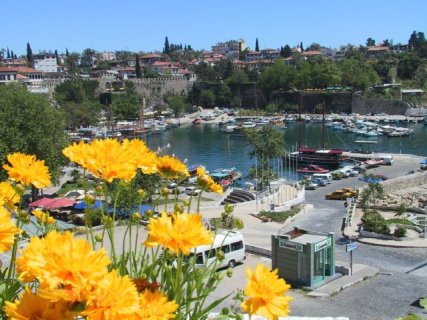
The Turquoise riviera
Antalya is a holiday paradise in a lovely natural setting. The pine-clad Toros Mountains sweep down to the crystal clear sea forming an irregular coastline of rocky headlands and secluded caves.
The region is bathed in sunshine for 300 days of the year and is thus perfect for a lazy holiday of sunbathing and swimming, or for sporting activities such as windsurfing, water-skiing, sailing, mountain climbing, hunting and spelunking. Those who vacation in March and April can ski in the mornings and in the afternoons swim in the warm waters of the Mediterranean. The coast is lined with magnificent beaches lapped by clear blue waters, and surrounded by pine forests, olive and citrus groves, palm trees, avocado trees and banana plantations. Important historical sites await discovery in these marvellous surroundings, which are home to a rich variety of plant and wildlife, and which are now protected as a conservation area. Holidaymakers will find everything here they can imagine for a perfect vocation. The Turkish Riviera is the tourist capitol of Turkey. With its wide ranging accomadition, from tourist class to deluxe hotels, the hospitable people of Antalya are always ready to welcome you.
Antalya
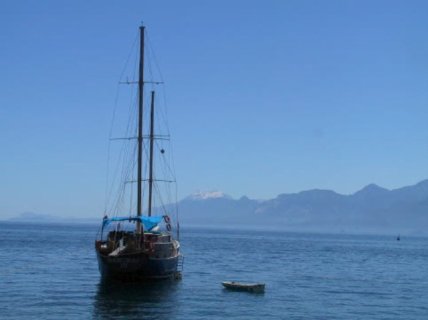 The principal holiday resort of the Mediterranean is the lovely region of Antalya with a majestic coastline of beaches and rocky coves where the towering Toros (Taurus) Mountains provide a magnificent backdrop. Antalya is an attractive city, at an altitude of only about 50 metres, with shady, palm-lined boulevards, a prize-winning marina and a picturesque old quarter called Kaleici which has narrow, winding streets and quaint, old, wooden houses next to the city walls. Since its founding in the 2nd century B.C. by Attalus II, a king of Pergamon who named the city Attaleia after himself, it has had a continuous history. The Romans, Byzantines and Seljuks occupied the city before it came under Ottoman rule.
The principal holiday resort of the Mediterranean is the lovely region of Antalya with a majestic coastline of beaches and rocky coves where the towering Toros (Taurus) Mountains provide a magnificent backdrop. Antalya is an attractive city, at an altitude of only about 50 metres, with shady, palm-lined boulevards, a prize-winning marina and a picturesque old quarter called Kaleici which has narrow, winding streets and quaint, old, wooden houses next to the city walls. Since its founding in the 2nd century B.C. by Attalus II, a king of Pergamon who named the city Attaleia after himself, it has had a continuous history. The Romans, Byzantines and Seljuks occupied the city before it came under Ottoman rule.
Places of interest in the city
Museums
Archaeology Museum: With remains from the Paleolithic Age to Ottoman Times, this is one of the most important museums in the Mediterranean region. (Open daily except Mondays.)
Ataturk Museum: This museum displays objects used by Ataturk, founder of the Turkish Republic. (Open daily except Mondays.) Suna-Inan Kirac Museum: This museum is connected to the Research Institute for Mediterranean Cultures.
Historical sites and monuments
Ancient City Walls: Since its founding in the 2nd century B.C., Antalya has had a continuous history. The ancient walls flank the city and other sections of the walls are still standing near the marina.
Clock Tower: Situated by the ancient city walls, it was part of the old city fortifications in the Kalekapisi Square.
Hadrian's Gate: The beautifully decorated, three-arched gate was built in honour of Hadrian when he visited the city in 130 A.D.
Hidirlik Tower: This tower was probably first built as a lighthouse in the 2nd century.
Karatay Medrese: This theological school dates from the 13th century and is situated in the Kaleici neighbourhood. The stone carvings on the portal and mihrap (prayer niche) are fine examples of Seljuk art.
Ataturk Monuments: One of the largest and most interesting monuments is located in Cumhuriyet Square within the city centre. The other one is in the center of Vatan Square.
Kaleici Quarter: This quaint area surrounding the Kaleici Marina is full of small hotels, pensions and restaurants as well as restored houses that all help to create the atmosphere for which the city is famous.
Mosques
Yivli Minareli Complex: It was built by the Seljuk Sultan Alaeddin Keykubat in the 13th century. Its elegant, fluted minaret has become the symbol of the city.
Kesik Minaret Complex: A memorial to the mixed history of Antalya is the Kesik (truncated) Minaret Mosque. Formerly a church, it has seen Roman, Byzantine, Seljuk and Ottoman modifications.
Tekeli Mehmet Fasa Mosque: An important 18th-century Ottoman mosque situated in the Kalekapisi district, inside the city walls.
Murat Pasa Mosque: The unique tile design of this mosque built in the 16th century is of particular interest.
Iskele Mosque: This attractive little mosque built in the 19th century is situated beside the marina. It was constructed of set stone and built on four pillars over a spring.
Parks and natural beauty
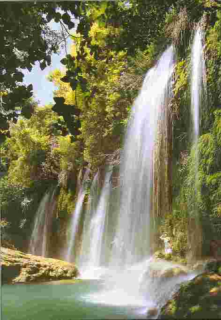
Karaalioglu: A magnificient view of Antalya awaits visitors here with colourful exotic flowers, vivid in the sunlight with the shimmering water of the bay and the mountains in the background.
Mermerli: Situated just above the marina at the southeast comer of the Kaleici district, this park is the best place for relaxation with a wonderful view of the mountains. Ataturk: This park also has a wonderful view of the city, displaying gorgeous flowers and an incredible scenic view.
Genclik: Situated on a peninsula, en route to Lara Beach you can see Duden Waterfalls from this vantage point, a most breathtaking view of the falls as they cascade into the sea. Yavuz Ozcan: A peaceful respite within Antalya's city centre. This park is delightful with its pools, miniature waterfalls and beautiful fountains which display colourful lights in the evening.
Recep Bilgin: This park, located not far from Yavuz Ozcan Park is situated within the city center and is worth a visit to see its architectural design.
Konyaalti Woods: Situated behind Konyaalti Beach, this park provides a nice, shady, cool place for rest and relaxation outside the city. The Upper Duden Waterfalls, 14 km to the northeast, are unique because you can walk behind the cascade. On the way to Lara Beach, 10 km to the east, are the Lower Duden Waterfalls that plunge straight into the sea. The nearby rest area offers an excellent view of the falls but the view is most spectacular from the sea. Kursunlu Waterfalls and Nilufer Lake, both 18 km from Antalya, are two more places where nature displays her beauty.
Beaches
Lara: This sandy beach is about 12 km to the east of Antalya city centre.
Adalar: Situated on the lower side of Karaalioglu Park, there are steps leading down to the beach which consists of little rocky islands. Beach facilities are available.
Mermerli: Situated near the Antalya Marina in the Kaleici district and located adjacent to Mermerli Park.
Konyaalti: This long, pebbled beach lies west of Antalya, where a breathtaking view of the mountains can clearly be seen. Topcam: This beautiful beach is situated at Olympos National Park, across from Sican Island.
Art, culture and entertainment
Antalya is full of exciting cultural activities and entertainment possibilities. The annual Altin Portakal Film and Art Festival held in the autumn and Antalya's annual jewellery festival are just a few of the many events available.
Antalya's Fine Arts Gallery offers performance exhibitions. The Aspendos Open Air Theater is a wonderful place to see international opera, ballet and symphony orchestras. Every year special classical performances are held here as well as performances by the most popular Turkish enter- tainers.
For evening entertainment, Antalya's Kaleici Marina and Leisure Centre is the best place in the city with many beautiful restaurants, cafes, bars, parks and discos in this area. Near Setur Marina, dining is available on floating seafood restaurants in an unpretentious and nautical atmosphere. For a pano- ramic view of the area there is a holiday complex and revolving restaurant, 15 km from Antalya, on top of Tunektepe Hill. One can also have a good time at the two water recreation parks Aqualand and Aquapark near the Culture Park.
A Culture, Exhibition and Congress Center was opened in 1996 in the Konyaalti Quarter. The Congress hall itself is in a glass pyramid.
Shopping
Some of the best shopping may be found in the Kaleici district, near the city walls. Meander down through the side streets in the old quarters where it's possible to find anything your heart desires. Old Turkish kilims, original gold jewellery, leather products, natural cotton clothing, handmade wood items as well as traditional Turkish handicrafts abound here. Ataturk, Cumhuriyet and Isiklar are the three other shopping avenues. Don't miss the colourful open air vegetable and fruit market, the place for food shopping as well as a great place for capturing that perfect picture.
Marinas
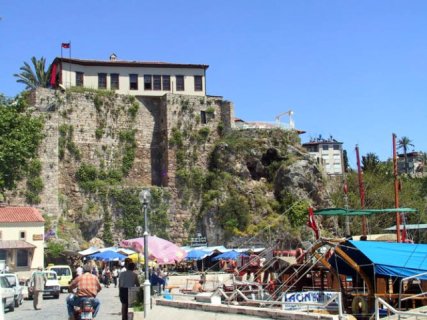 The Turban Kaleici Marina has won several awards and is considered one of the loveliest marinas in Turkey with an extraordinary blend of ancient and modern environmental design together with numerous shrubs, trees and exotic flowers. A peaceful respite from the hustle and bustle is Setur Marina located 10 km west of Antalya, offering all types of yacht services.
The Turban Kaleici Marina has won several awards and is considered one of the loveliest marinas in Turkey with an extraordinary blend of ancient and modern environmental design together with numerous shrubs, trees and exotic flowers. A peaceful respite from the hustle and bustle is Setur Marina located 10 km west of Antalya, offering all types of yacht services.
Golf
Golf lovers will not want to miss The National Golf Club in Belek which is one of the top modem holiday centers in Turkey. Belek is located 40 km west of Antalya and offers a championship 18-hole golf course as well as a 9-hole course and an academic course. This golf area is among shady pine forests not far from some of the nicest beach areas in the region.
Dialy excursions
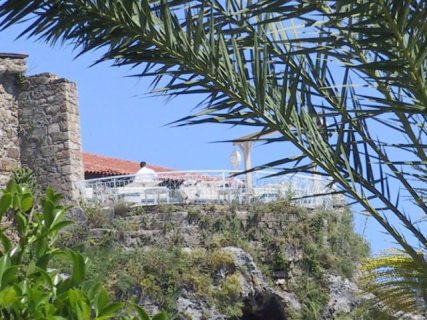 What could be more appealing than dreamlike landscapes, grand mountains , the magnificent colours of the sea and a rich variety of flora. Add to that the lively holiday life with the quiet of ancient ruins and you have a perfect vacaion. From Antalya there are many possibilities for day trips. The Bey Daglan (Olympos) National Park, Topcam Beach and camp grounds, at the north end of the park, are perfect for a visit, and for enjoying a view of the strangely perpendiculer Sican island the mountain resort of Saklikent, 50 km from Antalya, is an ideal winter sports center on the northern slopes of Bakirli Mountain at an altitude of 1750-1900 m. March and April are the months when you can ski in the morning, then in the afternoon go to the marina for a lunch of fresh fish, and end the day sunbathing on the beach, swimming or windsurfing- On the eastern side of Can Mountain, 30 km from Antalya, is Karain Cave, dating from the Paleolithic Age and the site of the oldest settlement in Turkey. The cave has a single entrance, lit by the morning sun, then moves into three large interconnecting chambers. The little museum at the entrance houses some of the remains, but most of the finds from mis cave are scat- tered in various museums throughout Turkey. In Duzlercami Park, 20 km north of Antalya, the deer and mountain goats are protected species. The very interesting 115-meter-deep Guver Canyon is 3 km south of the park.
What could be more appealing than dreamlike landscapes, grand mountains , the magnificent colours of the sea and a rich variety of flora. Add to that the lively holiday life with the quiet of ancient ruins and you have a perfect vacaion. From Antalya there are many possibilities for day trips. The Bey Daglan (Olympos) National Park, Topcam Beach and camp grounds, at the north end of the park, are perfect for a visit, and for enjoying a view of the strangely perpendiculer Sican island the mountain resort of Saklikent, 50 km from Antalya, is an ideal winter sports center on the northern slopes of Bakirli Mountain at an altitude of 1750-1900 m. March and April are the months when you can ski in the morning, then in the afternoon go to the marina for a lunch of fresh fish, and end the day sunbathing on the beach, swimming or windsurfing- On the eastern side of Can Mountain, 30 km from Antalya, is Karain Cave, dating from the Paleolithic Age and the site of the oldest settlement in Turkey. The cave has a single entrance, lit by the morning sun, then moves into three large interconnecting chambers. The little museum at the entrance houses some of the remains, but most of the finds from mis cave are scat- tered in various museums throughout Turkey. In Duzlercami Park, 20 km north of Antalya, the deer and mountain goats are protected species. The very interesting 115-meter-deep Guver Canyon is 3 km south of the park.
Termessos
Gulluk Dagi National Park is 34 km to the northwest of Antalya. The ancient city of Tennessos, set inside the park, is located on a high plateau at 1,050 meters on the west side of Gulluk Mountain (Solymos). Explore this ancient city and wander among ruins in a beautiful natural setting. At the park entrance is a nature and wildlife museum.
The coast west of Antalya
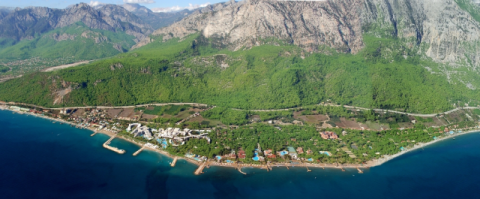 This is a land of exciting possibilities and quiet nature that has some of the top holiday resorts. Whether a quiet comer or lively entertainment, the choice is yours. Each bay and cove has its own special features. Discover archaeological sites, dive into blue waters and thoroughly relax on-this Coast of Light. Rising up immediately behind the coast are the mountains of the Bey Mountain Range, which, along with the coast from Konyaalh Beach to Kirlangic Peninsula, from the National Park named for the range. This area of mountains and coast makes up the beautiful, ancient Lycian Peninsula. The history of the area can be traced back to the Neolithic Age from the settlements at Beldibi, and to the Bronze Age from the finds at Semahoyiik on Elmali Plateau where Phrygian tumuli can still be seen.
This is a land of exciting possibilities and quiet nature that has some of the top holiday resorts. Whether a quiet comer or lively entertainment, the choice is yours. Each bay and cove has its own special features. Discover archaeological sites, dive into blue waters and thoroughly relax on-this Coast of Light. Rising up immediately behind the coast are the mountains of the Bey Mountain Range, which, along with the coast from Konyaalh Beach to Kirlangic Peninsula, from the National Park named for the range. This area of mountains and coast makes up the beautiful, ancient Lycian Peninsula. The history of the area can be traced back to the Neolithic Age from the settlements at Beldibi, and to the Bronze Age from the finds at Semahoyiik on Elmali Plateau where Phrygian tumuli can still be seen.
Kemer
The 42 kilometres of road from Antalya to Kemer go through spectacular mountain scenery. This resort town has been designed to blend in with the scenery and offers the perfect environment for a wonderful holiday. There is a fully equipped marina and the unspoilt bays and beaches south of the town are a yachtsman's dream. Shoppers will delight at the wonderful range of high quality souvenirs that can be bought here. There is a beach promenade on the northern part of the marina which has steps leading down from its cafes and shops directly to the beach. Kemer Beach is rated Blue Flag (meaning "clean beach") by the European Union. In the Yoruk (Nomad) Theme Park, overlooking a lovely bay, you can watch traditional craftsmen at work. Along the adjoining bay is a charming and delightful spot with sports and entertainment. facilities discreetly hidden in pine groves. The colorful Kemer Carnival is held in the spring. Also in the spring are the yacht races between Kemer and Gime (in the Turkish Republic of Northern Cyprus). Kiziltepe, Goynuk (Blue Flag) and Beldibi (Blue Flag), north of Kemer, and Camyuva and Tekirova (Blue Flag), to the south, are tourist centres that provide for a variety of activities and holiday villages all built to blend into the forest that encircles them. Of all the beautiful places in the Kemer region these areas are the favourites.
Phaselis
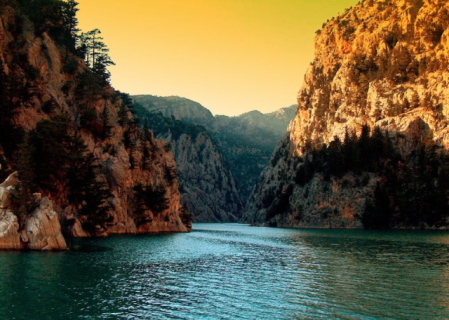 Situated at the foot of Mt. Tahtali (Olympos), 15 km south of Kemer, the three harbours of Phaselis were the reason for its historical role as a commercial centre. The view of Mt. Tahtali from the south harbour is particularly spectacular. The sheltered, pebbled and sandy beaches around the bays are delightful and the waters here are calm and safe for children and young swimmers. The ruins of aqueducts, agoras, baths, a theater, Hadrian's Gate, and an acropolis underline the city's historical importance.
Situated at the foot of Mt. Tahtali (Olympos), 15 km south of Kemer, the three harbours of Phaselis were the reason for its historical role as a commercial centre. The view of Mt. Tahtali from the south harbour is particularly spectacular. The sheltered, pebbled and sandy beaches around the bays are delightful and the waters here are calm and safe for children and young swimmers. The ruins of aqueducts, agoras, baths, a theater, Hadrian's Gate, and an acropolis underline the city's historical importance.
Olympos
This ancient city is situated on the southern side of Mt. Tahtali. Whether coming by sea or land do not miss the Olympos Valley shaded with oleander and laurel shrubs and the refreshing quiet pools of flowing water. The design of the mosaics in the Olympos bath is enhanced by the play of light while a temple gate and a theatre are of interest along with the other walls and towers around the bay which date from the Middle Ages. North of Olympos, up from Cirah Beach, is Yanartas (at a height of 300 m) where, according to mythology the rire breathing monster, Chimaera, was slain by the Lycian hero Bellerophon who was mounted on his winged horse, Pegasus. Nearby you can see remains from the Byzantines who attached religious importance to the area. Tranquil waters and sandy beaches line the Bay of Cavus, situated south of Olympos. This enchanting bay is yours for an unforgettable experience of water-skiing on glassy water, for discovering the colorful marine life in waters clear enough to see to the bottom, or exploring the incredible sea caves on the northern shore.
Finike
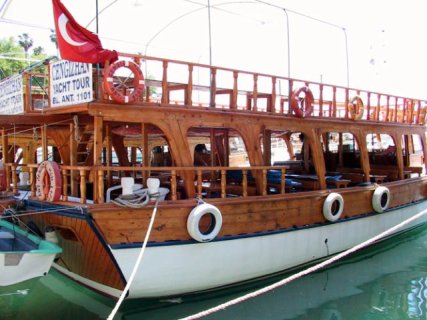 This town surrounded by citrus trees and gardens is a port of entry into Turkey lying to the west of Olympos. A sandy beach stretches to the east, and to the west are rocky bays and coves. Limyra, an ancient city of Lycia, is 10 km from Finike via Turuncova. On the south side of the acropolis is the Pericles Mausoleum Monument. Decorated with caryatids of the 4th century B.C., it is not to be missed. City walls and a theatre are also of interest.
This town surrounded by citrus trees and gardens is a port of entry into Turkey lying to the west of Olympos. A sandy beach stretches to the east, and to the west are rocky bays and coves. Limyra, an ancient city of Lycia, is 10 km from Finike via Turuncova. On the south side of the acropolis is the Pericles Mausoleum Monument. Decorated with caryatids of the 4th century B.C., it is not to be missed. City walls and a theatre are also of interest.
Arikanda
Along a mountain road of unsurpassed beauty, about 32 km from Finike, is the rum off for the Lycian city of Arikanda. Set high on the mountain side with plenty of fresh air and cool water, it is no wonder such a place was chosen. In the extensive ruins, the agora, theater, stadium, bouleuterion and water system are of interest. Memorial graves are set in the hillside while an ancient bath and gymnasium over- look one of the most beautiful valleys.
Demre (Kale)
This site is the ancient Myra (25 km to the west of Finike) and it is best known for St, Nicholas, the bishop of this Mediterranean city during the 4th century, who died here in 342 A.D. Every year in December the St. Nicholas Commemoration Ceremony is held, attracting many tourists who spend their Christmas holiday on the sunny coast of ancient Lycia. In ancient Myra, many rock tombs overlook the splendid theater. Dalyanagzi, the ancient harbor of Andriace, 6 km west of Demre, is perfect for swimming as well as relaxing on the sandy beaches.
Kekova
An hour from Dalyanagzi by sea, especially enjoyable for yachtsmen, is the island of Kekova, "home of the sun." Kekova is also the name for this entire area of picturesque islands, numerous bays and ancient cities. These bays provide natural harbours in all seasons and here, too, nature is joined by history to cre- ate a harmony rarely seen, Geological shifting along the northern shore of Kekova Island (Apollonia) over the years has caused some of the ancient structures to sink under the clear water, creating a sunken city. A bird's eye view of the whole scene of bays, inlets, islands, and yachts sailing peacefully on the smooth water can be seen from the Kalekoy Castle (Simena). The colors of a Van Gogh painting and orange sunsets, together with starry, starry nights, peace and tranquility, playful dolphins, mythological mysteries, and the sparkling sea - Kekova provides all this and more.
Kas
West out of Kekova is a lovely spot surrounded by mountains. When you feel like exploring further, the choice of coves, bays and beaches is almost endless. The local fishermen are very friendly and are happy to run a water-taxi service to take you to a favourite bay along the coast. The area around Kas has remained completely unspoiled, and for people who enjoy swimming it is ideal. Kas is perfect for the diver who wants to explore the underwater world.Visiting the theatre and the Lycian tombs, the largest of which is in the centre of town, will help you relive the days when it was called Antiphellos. And wandering through the streets, you can stop to examine the souvenir shops specializing in Turkish handicrafts, various leather goods, copper and silver items, cotton clothing, and the inevitable handmade carpets. After your shopping is done, stroll along the flower-lined Ak^pniz Promenade, relaxing under the shade of palm trees and enjoying the scenery. Kas also offers just the kind of night life you might want - bars and restaurants are plentiful, and whatever pleases you most, you will find it there. Kas is the perfect spot from which to take a refreshing trek into the mountains. Walk through forested hills, visit remote villages and ancient remains while climbing to the high ridges for a superb view. For the energetic, there is the option of climbing the highest peak in the area, Mt- Kizlarsivrisi (3086 m) and the second highest, Mt. Akdag (3030 m). Kaputas, 18 km from Kas along the scenic Kalkan Road, has a beautiful beach with the Turquoise Grotto ate one end.
Kalkan
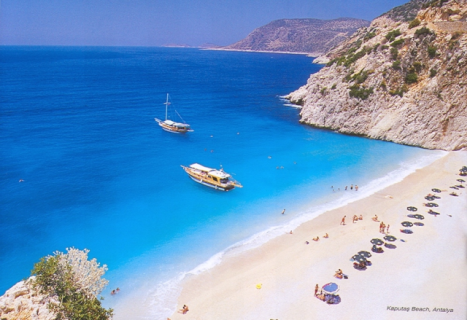 Kalkan is 7 km west of Kaputas. It is a lovely, small town with an abundance of charm, perched on a hillop overlooking a tiny bay. It has quaint, traditional, white-washed houses with shuttered windows, and balconies with garlands of flowers hanging to the streets below. Kalkan is the ultimate for a peaceful holiday. Narrow, winding streets lined with souvenir shops lead down to the charming marina. Every morning boats are busy taking tourists to one of the nearby beaches or small bays. As the sun sets, Kalkan style is to go up to the rooftop terraces for a relaxing drink before dinner taking in the comings and going of the yachts in the bay, the business of the marina and the panoramic view.
Kalkan is 7 km west of Kaputas. It is a lovely, small town with an abundance of charm, perched on a hillop overlooking a tiny bay. It has quaint, traditional, white-washed houses with shuttered windows, and balconies with garlands of flowers hanging to the streets below. Kalkan is the ultimate for a peaceful holiday. Narrow, winding streets lined with souvenir shops lead down to the charming marina. Every morning boats are busy taking tourists to one of the nearby beaches or small bays. As the sun sets, Kalkan style is to go up to the rooftop terraces for a relaxing drink before dinner taking in the comings and going of the yachts in the bay, the business of the marina and the panoramic view.
Patara
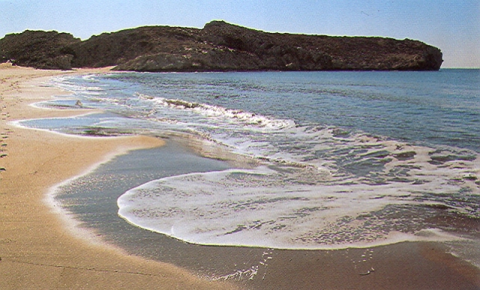 A principal harbour of ancient Lycia, Patara can be reached by travelling west out of Kalkan along a winding mountain road, entering the Esen Valley and then, after 8 km, you come to the ancient harbour. According to mythology, Apollo was born here. Historically, it is known to be the birthplace of St. Nicholas. The ruins are numerous and interesting. This is also the place for beach lovers, for it has 22 km of pure white sand which stretches as far as the eye can see, making it a natural choice for sports like sand-surfing. Undoubtedly one of the most beautiful beaches on the Mediterranean, it is ideal for a holiday away from the crowds.
A principal harbour of ancient Lycia, Patara can be reached by travelling west out of Kalkan along a winding mountain road, entering the Esen Valley and then, after 8 km, you come to the ancient harbour. According to mythology, Apollo was born here. Historically, it is known to be the birthplace of St. Nicholas. The ruins are numerous and interesting. This is also the place for beach lovers, for it has 22 km of pure white sand which stretches as far as the eye can see, making it a natural choice for sports like sand-surfing. Undoubtedly one of the most beautiful beaches on the Mediterranean, it is ideal for a holiday away from the crowds.
Kinik (Xanthos)
The ancient Lyrian capital of Xanthos is 18 km north of Patara near the Esen River. The theatre. Harpy Tomb, Nereid Monument, agora, and an inscribed monument are of interest, as are a mixture of ruins from Lycian, Roman and Byzantine times. At the Lycian cultic center of Letoon, 6 km farther, there are three temples dedicated to Leto, Apollo and Artemis, familiar gods of Anatolian mythology.
The coast east of Antalya
Wide fertile plains stretch parallel to the endless sandy beaches rimmed by the shining sea. Modem tourist facilities dot this coast and the historical sites are well preserved, giving you the option of several activities in a day.
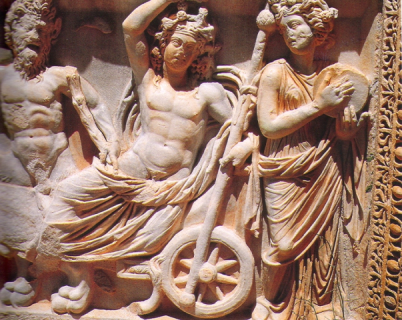
Perge
The Hittites had settlements in this area around 1500 B.C., and St. Paul stopped here on one of his jour- neys during the time when Perge (18 km from Antalya) was an important city of ancient Pamphylia. The stage of the theatre has very nice marble relief work. On the outer wall is a three-sectioned memorial fountain. Some of the reliefs from the city are displayed in the stadium for easy viewing. Other ruins worth mentioning are the handsome city gate flanked by two lofty towers, a long colonnaded street that was once lined with shops and mosaic pavements, a large agora, and buildings that used to house the baths and gymnasium.
Belek
Golfers, swimmers, and sun-worshippers will not want to miss this modem holiday center and golf paradise, 40 km from Antalya - the perfect blend of aesthetics and nature on the sea with sandy beaches and shady pine forests.
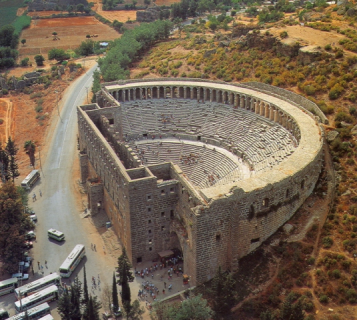
Aspendos
A photogenic Seljuk bridge crosses the Kopru River from the road to Aspendos, 49 km east of Antalya. The road continues past the Aspendos Jewellery Centre to the ancient city of Aspendos a site which is dominated by the best preserved theater of antiquity with seating for 15.000. The galleries, stage decorations and acoustics all reflect the ability of the architect Zenon. Close to the theatre, basilica and agora lie the remains of an aqueduct, one of the largest in Anatolia. Be sure to visit the Aspendos Jewellery Centre, where jewellery making can be observed at every stage in the large workshop.
Koprulu Canyon National Park
Northeast of Antalya on the Side road take the turn off for Tasagil and Beskonak, for the beautiful circular, scenic route that leads to the Koprulu Canyon National Park. The road crisscrosses over the clear, flowing water of the mountain river and passes through virgin forests and over rippling waterfalls. You will want to stop often and give your camera a workout in this picturesque valley. Reaching the park, 92 km from Antalya, you will encounter a valley of wild beauty rich in flora and fauna. The canyon stretches for 14 km along the Kopru River and is 400 metres deep in some places. At the rest area there are fish restaurants offering delicious selections. The Roman Oluk Bridge over the canyon and the Bugrum Bridge over the Kocadere stream were engineering feats in their time. From this park there are two other possible excursions: the ancient city of Selge and the Dedegol Mountains. The highest peak in this mountain range is Dedegol at 2,992 metres. Mountaineers will be unable to resist climbing, exploring and camping in this rugged, scenic spot. Return to Antalya via the other half of the scenic route.
Altinkaya (Selge)
An important city of ancient Pisidia, Altinkaya is reached from the Koprulu Canyon National Park then, at Oluk Bridge go 12 km to the northwest on a winding mountain road. This ancient route coming from Antalya shows that Selge had direct trade connections. The fairy chimneys seen on the way are typical of this area. This city, at 950 metres, has ruins of city walls, towers, cisterns, a temple to Zeus, an agora, stadium, theater, gymnasium and necropolis. All around the canyon are other historical remains of this once-famous city.
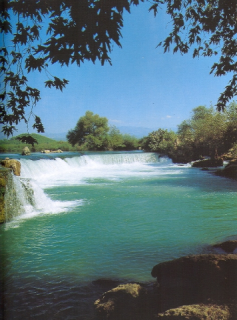
Manavgat
The Manavgat Waterfalls (80 km to the east of Antalya) are not high but the current is very powerful and the water rushes milky-white over the rocks. Near the waterfalls are shady tea gardens, restaurants and souvenir shops, making it a pleasant, cool, rest stop, especially welcome after a day of sightseeing. It is possible to take a delightful boat trip on the Manavgat River and explore this lovely area.
Side
Side is one of the best-known classical sites in Turkey. This was an ancient harbour whose name meant "pomegranate" Today, it is a pretty resort town, very popular because of its ancient ruins, two sandy beaches, a variety of shops and plentiful tourist accommo- dation. There are numerous cafes and restaurants with a view uf the sea, and the narrow streets are lined with shops selling typical Turkish handicrafts including handmade leather and magnificent gold jewellery. Discos are just a part of the active night life. The magnificent theatre of the ancient city, built on colonnaded arches, is the largest in the whole area. Next to the theatre is an agora. The creamy-white columns of the Apollo Temple make a striking contrast against the blue sea. The extensive Roman bath, now a museum, houses one of Turkey's finest archaeological collections. The west side of Side also has holiday resorts, including the inviting spots of Kumkoy and Colakli (Kamelya). Here, too, you can enjoy the sun and sea while being close to antiquity. East of Side, tucked in pine forests, are the three holiday resort areas of Sorgun, Titreyen G61 (Blue Flag) and Kizilagac, all popular for their sandy beaches and shimmering sea. The atmosphere is relaxed, accommodation plenti- ful and the activities endless, promising an unforgettable holiday.
Bucaksihlar (Pamphylian Seleucia)
In Bucaksihlar, 15 km northeast of Side, are the remains (in good condition) of an agora, Roman baths, temples, churches, and a mausoleum. Nestled in the forests, it makes for a lovely and peaceful excursion.
Altinbesik Cave National Park
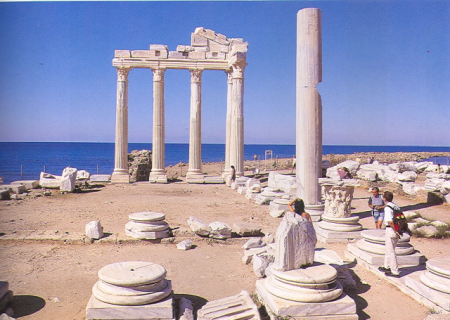 One of the most interesting and well-known caves is located in Altmbesik Cave Park 12 km southeast of Aydinkent (Ibradi) and 55 km north of Manavgat. Interesting rock formations within the cave area, as well as travertines and streams make this area especially fascinating. AItinbesik Cave is in the western slopes of the Manavgat River Valley and can be reached via the village of Urunlu, which is an authentic village and a must-see in itself when travelling through this area.
One of the most interesting and well-known caves is located in Altmbesik Cave Park 12 km southeast of Aydinkent (Ibradi) and 55 km north of Manavgat. Interesting rock formations within the cave area, as well as travertines and streams make this area especially fascinating. AItinbesik Cave is in the western slopes of the Manavgat River Valley and can be reached via the village of Urunlu, which is an authentic village and a must-see in itself when travelling through this area.
Alarahan
The 13th-century caravanserai, Alarahan was built by the Seljuk sultan Aleaddin Keykubat on the banks of the Alara River, 38 km east of Manavgat. At the top of a nearby hill is the Alara Fortress, from which there is a commanding view of the whole area.
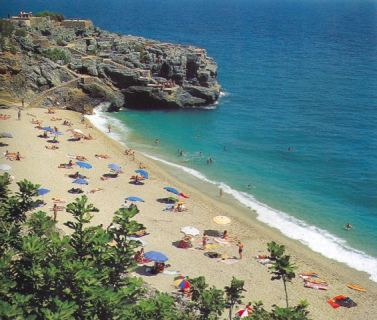
ALANYA
The large, popular resort center of Alanya is nestled at the foot of a rocky promontory which juts out between two sandy beaches and is crowned by a 13th-century Seljuk fortress which is one of the most magnificent sights on the Mediterranean. The well-preserved, double-walled fortress has 150 towers and stands 220 meters above the sea. Within the outer walls are ruins of mosques, a caravanserai and a covered bazaar; within the inner walls and toward the top are ruins of a cistern and a Byzantine church. In 1220, Sultan Aleaddin Keykubat made Alanya his winter residence and naval base. Near the harbour are the unique, arched boat yards and the large, impressive, octagonal Kizil Kule (Red Tower), both Seljuk structures. Alanya is a beautiful holiday center of modem hotels and motels as well as numerous fish restaurants and cafes near the sea along the sandy beaches. These cafes fringing the harbour have become a popular gathering spot for tourists. From the lovely flower park, the road runs along the coast to the harbor lined with countless boutiques tempting the tourist with handicrafts and souvenirs such as leather wear, jewellery, handbags, and the amusingly painted gourds which are a symbol of the area. Whether taking a photo from the fortress at sunset or strolling along the streets, this is a great place for a holiday. The harbour, the long white beaches, the brilliant turquoise waters, and the foothills of the Toros Mountains sloping down to the sea make Alanya as picturesque as anywhere on the Mediterranean. As if the scenery were not enough, in August a colorful International Folklore Festival is held, adding to the holiday atmosphere. Damlatas Cave is extremely old, with wonderful multicolored stalagmites and stalactites. Nearby is the Archaeology and Ethnography Museum, and Ataturk Park is a good place to rest and enjoy the scenic mountains, fortress and sea. Of special interest are three sea caves (grottoes): Fosforlu Magara, (Phosphorescent Cave) with its phosphorescent rocks; the Kizlar Magarasi, (Girls' Cave) where pirates kept their female captives; and the Asiklar Magarasi (Lovers' Cave). These can only be reached by boat. An alternative to sunny days on the beach is a trip to the Dim Cayi Valley 15 km east of Alanya. Relax in the shade of this marvellous, naturally scenic valley next to a nearby murmuring stream. At Avsallar (incekum), about 25 km west of Alanya, beautiful sandy beaches and holiday complexes can be found, ensuring a vacation full of excitement. If you travel from Alanya to Gazipasa you will find exceptional beaches en route.The best beaches are located in the village Zeytinada where is the last village of the Antalya state.The road to Anamur will also delight you with its mountain scenery and natural beauty. Thirty kilometres east of Alanya is
Aytap, the historical harbor city of lotape. Roman ruins, secluded beaches and bays make it a great excursion.
How to get there
By plane to Antalya then transfer to holiday areas. By bus service from all over Turkey to holiday areas. By sea-chartered and private yachts; cruises from all over the Mediterranean.
Climate
Typical Mediterranean climate with sunny summers and mild winters. Swimming April - November. Average daytime temperature in summer is 28°C and the water is 27°C.
Average air and water temperatures
|
|
Jan |
Feb |
Mar |
Apr |
May |
Jun |
Jul |
Aug |
Sep |
Oct |
Nov |
Dec |
|
Air |
10 |
11 |
13 |
16 |
20 |
25 |
28 |
28 |
25 |
20 |
15 |
12 |
|
Sea |
17 |
17 |
18 |
21 |
22 |
24 |
27 |
28 |
27 |
25 |
22 |
19 |